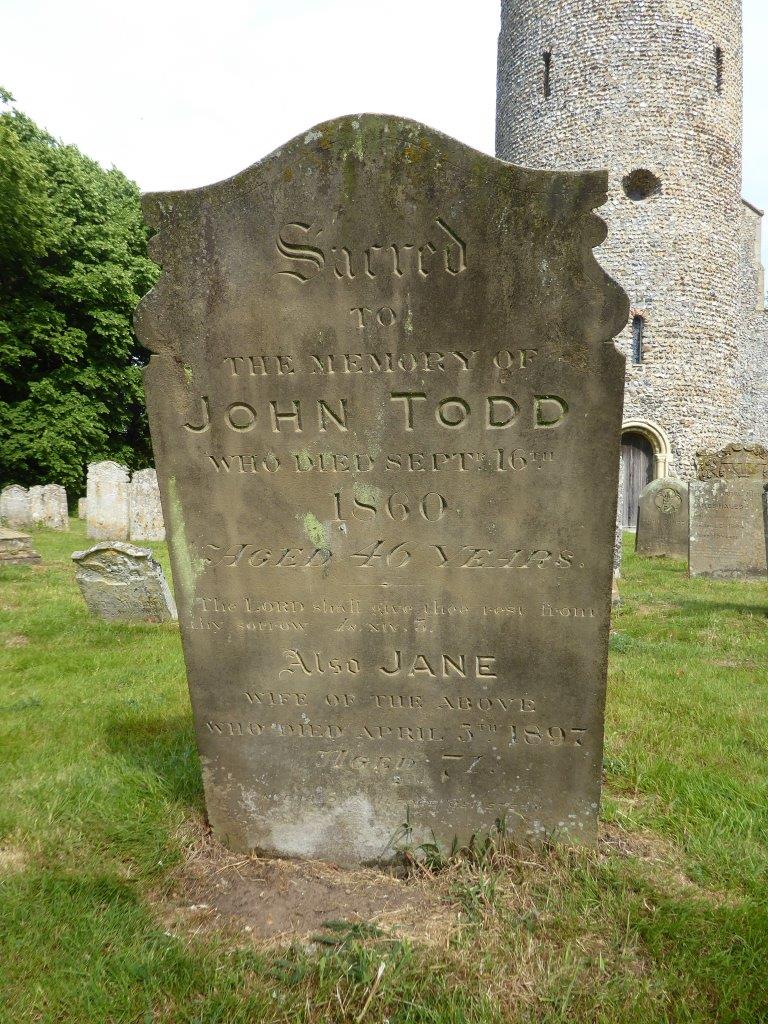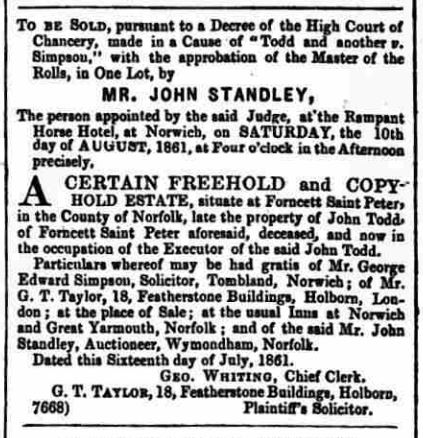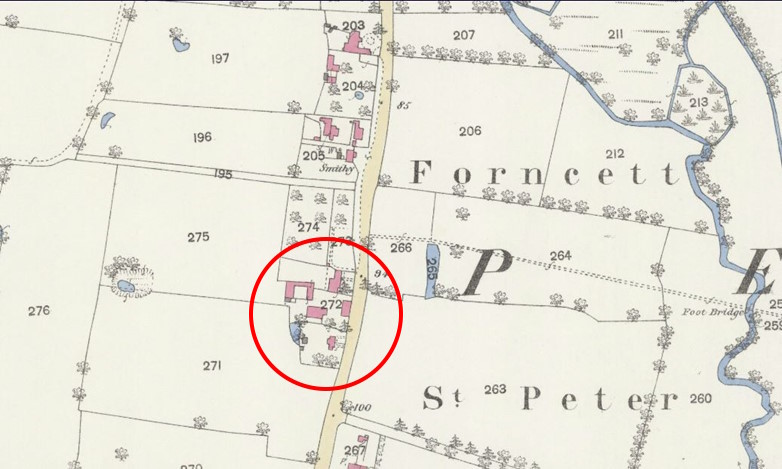
Church Farm - Low Road
Church farmhouse is an imposing 17th century timber-framed house on Low Road in Forncett St Peter. The house has a plastered exterior and a tiled roof with two attic dormer windows. Much of our knowledge of the farm's history comes from a copy of the deeds that were deposited with the Norfolk Record Office in 2005 (NRO – MC2349).
The history of the farmhouse
Purchase by Edward Betts in 1795
Although the house was probably built in the mid 17th century, the deeds only commence in 1795 when Edward Wiseman Betts bought the farm from James Brock for the sum of £73 10s. Brock was 79 years old and had farmed in Forncett for many years. At the time the house was occupied by Robert Sheering who came from Ashwellthorpe.

Sale of Church Farm in 1795 (excerpt from the deeds)
Edward Wiseman Betts was born in 1764 in Great Moulton. His middle name "Wiseman" derives from his grandmother, Jane Wiseman, and seems to have been used rather sporadically to distinguish men named Edward in this lineage of the Betts tree from other local men called Edward Betts (of whom there were many!).
Edward Wiseman Betts married Mary Derisley, in Great Moulton in 1784 and the couple moved to Forncett where they had four daughters; Mary, Sarah, Jane and Ann, and one son, also called Edward Wiseman Betts. Jane Betts married John Palmer and went to live in Welborne where she died, aged 43, in 1832. Mary Betts married a local farmer, James Todd, and they farmed in Aslacton and Forncett. Ann Betts married a local farmer, Thomas Adcock Hardy, and they farmed in Forncett, and Edgefield. Sarah Betts never married.
When Edward Wiseman Betts snr. bought Church Farm, in 1795, he was 31 years old. He died in 1803, aged only 40, and whilst his son may have formally inherited the farm, he was only 13 at the time and the farm was probably managed by his mother, Mary, who lived until 1819. We don't know the extent of the land that Edward Betts snr. bought from James Brock in 1795. However, by 1813 the enclosure map of Forncett (below) shows that his son, Edward Wiseman Betts, who was now 23, owned a very considerable acreage along the Tas valley, including at least three properties: Bishops House, Church Farm and Clavers Cottage.

It would appear that Edward's relatives were very concerned about his mental health, and consequently his ability to manage his estate, because in January 1820 an inquisition into the alleged lunacy of Edward Betts was set up. On 11th May 1820 the commission found that "the said Edward Betts was a lunatic with lucid intervals". It was also confirmed that Edward's co-heirs were his four sisters; Sarah Betts, Jane Palmer, Mary Todd and Ann Hardy.

Extract from the deeds of Church Farm
The 1820 report said that Edward and his heirs then owned some 173 acres of land and a number of dwellings in Forncett and Wacton. The 1839 tithe records show that Edward owned 151 acres in Forncett and he was the second largest landowner in the parish.
Like his sister, Sarah, Edward Wiseman Betts jnr. never married. In 1841 Edward and Sarah were living together at Bishops House and were described as "independent". Church farmhouse was occupied by John Ringer (farmer, aged 60) and his two children. Then, in 1848, Edward Wiseman Betts died: he was 58. There was clearly some dispute over the inheritance of his properties because in February 1849 Edward's co-heirs took a successful petition to the Lord Chancellor in London requesting that the title deeds and documents relating to Edward's estate were handed over by Edward's cousin, William Betts, who was a farmer in Bunwell. The co-heirs were then able to redistribute the estate.
Transfer to James Todd in 1849
The 1839 tithe map shows that Ann Hardy's husband, Thomas, owned 95 acres of land in Forncett St Peter, including Corner Farm on Low Road (where they were living), the dwellings around the smithy, and the smock mill at the top of Mill Lane. However, Thomas Hardy died in 1845 leaving Ann widowed with four children. By 1849 Jane Palmer (née Betts) had also died and so her share of the estate passed to her son, Thomas Palmer, who had recently taken over the running of Corner Farm, Forncett End, from his grandfather.
So, in November 1849 large parts of the Betts estate were redistributed. Some land was transferred to William Betts and three parcels of land that were bought by the Alborough family who subsequently built Alborough farmhouse on Mill Lane, Alborough house on Valley Farm Lane, and Falgate cottages on Northfield Lane.
Sarah Betts retained Bishops House and the surrounding land; a total of 5 acres. James Todd (husband of Mary, née Betts) acquired 16 parcels of land totalling about 41 acres, which included Church farmhouse and Clavers cottage. For this he paid his co-heirs the sum of £1515 (around £150,000 today). So, Sarah Betts, Ann Hardy and Thomas Palmer each received £505. There was however a fifth party to this agreement – one George Edward Simpson, a solicitor from Norwich who presumably funded a mortgage for James Todd.
Consequently the 1851 census records Ann Hardy living with three of her children and her sister Sarah at Bishop's House. Sarah Betts was described as an annuitant, suggesting that she was retired and receiving an income from her estate. Ann Hardy was farming the 5 acres and her eldest son, Thomas Hardy jnr, was running the mill at the top of Mill Lane.
1851 was a time of great change because in March of that year Mary Todd died, leaving James Todd living at Church farmhouse with two of his daughters and a servant. He was farming 64 acres and employing 4 men, so he had apparently expanded the farm from the 41 acres that he started with in 1849. There was further change when James Todd died in 1856 and Church Farm was taken over by his son, John. However, John Todd also passed away in 1860 leaving his wife, Jane Todd (née Palmer), with four children under five years old. So, in 1861 Jane was living at Church farmhouse with her children, her sister-in-law Katherine, and a servant. Jane was farming 120 acres, so the farm had grown even more, suggesting that the Todd's had probably increased their borrowing quite substantially.

The grave of John and Jane Todd in St. Peter's churchyard
John Todd's executor was George Edward Simpson who had originally advanced a sum of £700 to James Todd for the purchase of the farm. However, a document amongst the deeds of Church Farm, dated 16th January 1864, shows that Simpson had subsequently advanced more money and was now owed more than £1900. The estate was valued at £1335 and in addition Jane Todd had very substantial debts of £335! So, following a legal case between the Todd family and George Edward Simpson, the farm was put up for sale by Mr. Simpson in July 1861.

Norwich Mercury 24 July 1861
Jane Todd continued living in Forncett, on Mill Lane, until at least 1881, after which she moved to London to live with her son, James. She died in 1897 and is buried at St. Peters in Forncett.
The Tooley family
In June 1862 Church Farm was bought by Samuel Tooley for the sum of £1450. However, he clearly didn't buy the whole of the farm previously run by John Todd because in 1871 and 1881 Samuel Tooley was farming just 54 acres and 62 acres respectively. Presumably the remaining 70 acres or so was sold separately to recover George Simpson's investment.
Samuel Tooley was born in Mattishall and he had farmed there together with his older brother, Peter, until 1862 when he married Mary Dunthorn, also from Mattishall, and they moved to Forncett. Although they are some 15 miles apart, there are strong farming links between Forncett and Mattishall. Jane Palmer, the wife of John Todd, and Thomas Palmer, who owned Corner Farm in Forncett End, were both born in Welborne near Mattishall. So, it's perhaps not surprising that Samuel should have moved from Mattishall to Forncett to start his own farm.

Church Farm on 1884 OS map
In the next seven years Samuel and Mary Tooley had four daughters; Alice (b.1863), Minnie (b.1865), Edith (b.1867) and Kate (b.1869). Neither Alice nor Minnie married, but in 1896 Kate married Thomas Kerridge, a widower who she met in Lowestoft whilst working as a draper's assistant. They then stayed in Lowestoft where Thomas worked in a grocer's shop. In 1898 Edith Tooley married John Thurston, a widower who was farming near Stanfield Hall outside Wymondham, and following the wedding the couple moved to Bayes Farm in Forncett St Mary. John had a son, Warren, from his previous marriage and then in 1899 a daughter, Marjorie Edna Thurston, was born.

John, Edith, Warren and Marjorie Thurston at Bayes Farm - 1900 (photo - Tom Nokes)
When Samuel Tooley died in January 1892, his wife Mary took over the job of running Church Farm, together with her daughter Minnie. Alice was still working as a draper's assistant in Norwich.

Mrs. Mary Tooley, Minnie Tooley and Warren Thurston at Church Farm - circa 1896
Throughout his time at Church Farm Samuel had employed two men to help him and so after his death it seems likely that the farm continued to be worked by two farm labourers. When Mary Tooley died, in October 1905, Alice returned to Forncett to run the farm with her sister Minnie. The two sisters ran the farm until 1914 when Minnie died (age 49).
When Samuel Tooley bought the farm in 1862, he was lent money by three gentlemen who subsequently "sold on" their interest in the farm to a lady called Julia Sarah Baker from Stoke Newington in London. In March 1907 (probably following Mary Tooley's death) Ms. Baker drew up a new agreement with Alice, Minnie, Edith and John Thurston, and Kate Kerridge. However, in February 1915, Alice Tooley bought the farm from Ms. Baker by payment of £1900 plus any outstanding interest. So, the farmhouse and associated land was now owned by Alice Dunthorn Tooley.

John and Warren Thurston on River Tas, circa 1905 (photo - Tom Nokes)
On 7th May 1915 John Warren Thurston died. He was just 24 years old and was returning from having spent time in Canada and was onboard the Lusitania when the ship was torpedoed off the coast of Ireland by a German U-boat. 1,198 of the 1,959 people aboard were killed.
Six years later, in March 1921, Alice Tooley sold Church Farm, including the farmhouse, Clavers cottage and 55 acres of land, to her brother-in-law John Thurston. The 1921 census (taken in June) records the Thurston family were now living at Church Farm but Alice Tooley wasn't present. However, Alice died at Church Farm in 1939, aged 75.
The Thurston family at Church Farm
Members of the Thurston family lived at Church Farm for at
least 70 years and Marjorie Thurston left an extensive collection of
photographs that offer a remarkable insight into life at Church Farm during
much of the 20th century.

John Thurston (centre) feeding chickens outside the stockyard

John and Edith Thurston

Marjorie Thurston outside Church Farm
In 1921 John Thurston was running the farm with the support
of a horseman, James Blake snr., who lived at Claver's Cottage. However, in the
1939 register John Thurston described himself as a "retired farmer" but he was
presumably helped by William Blake who lived next door at Stone Cottage. By
1939 Edith Thurston was an invalid and Marjorie, who was 40 and still single,
was running the house and keeping poultry. John Thurston died in July 1942 and
left £1695, worth around £95,000 today. Edith lived until 1954.
Marjorie had had a "boyfriend" since she was a teenager. Richard (Dickie) Sutton was eight years older than Marjorie and lived in Norwich. He was a motor engineer which may be how they met because Marjorie was apparently fascinated by cars and motorbikes. Dickie served in the RAF during WWI. When Marjorie's parents died, Dickie moved into Church Farm and lived there with Marjorie until his death, age 89, in 1981.
Marjorie continued to live alone at Church Farm until she passed away on 4th June 1990 just short of her 91st birthday. She left an estate of £187,000. Marjorie had outlived all her cousins and so Church Farm passed to Norman Kerridge, the son of Marjorie's cousin Arthur Kerridge. Norman, who was a retired engineer, took on the task of renovating Church farmhouse which was in a poor state and had been largely untouched for decades. Outside, the house had a new tiled roof and new render, and inside it had new wiring, new plumbing and underfloor heating with all the bricks and pamments from the original floors being relaid. The loft rooms were made into bedrooms but otherwise the essential layout of the house was retained and it remains largely as it had been for many years, probably at least since Samuel Tooley moved in in 1862. The work was completed in 1991.
Norman Kerridge also renovated the Stockyard behind the farmhouse which was converted to a residential building in 1992. Norman's sister, Jill Gilleberg (née Kerridge), who had been living in Canada, then moved into the converted stockyard which is now called Church Farm Barns. In 2005 Jill deposited the deeds of Church Farm with the Norfolk Record Office (Ref. MC2349). The recollections of Jill's father, Arthur Kerridge (1897-1990), of life at Church Farm in the early 1900s were published in the Forncett Flyer in 2005.

Norman Kerridge died in October 2000 and the
following year his wife, Peggy, sold the farmhouse, bringing to an end an
association of nearly 140 years with the same family.
With particular thanks to Debbie Sutton, Lindi and Tom Staunton, and Claire and Mike Jordan for their invaluable help in researching this page.
